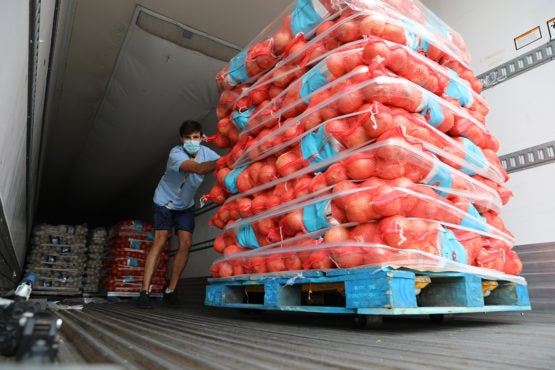Stanford students help connect farmers with food banks
Stanford sophomores James Kanoff and Stella Delp created the not-for-profit FarmLink to salvage surplus food from farmers and donate it to overwhelmed food banks.
As COVID-19 has devastated the U.S. economy, it’s intensified serious problems in the national food system – problems that Stanford students are working hard to address.
In recent months, shuttered restaurants, stores and schools have canceled contracts with many farmers who, lacking a market and method of distribution, have been forced to throw out their surplus food. In the meantime, food banks across the country have become overwhelmed by a steep rise in demand as more and more Americans find themselves out of work.
“The farmers want to donate [their surplus food], but they can’t afford to take on the associated costs, like packaging and transporting it,” said James Kanoff, ’22.
Frustrated by the amount of food being wasted when need for it is so high, Kanoff and his friends, including fellow Stanford student Stella Delp, ’22, stepped up to help with a grassroots effort that started locally and has now garnered national attention.
The need to do something
“With so many things happening in the world right now that are problematic, we really felt a need to do something,” Kanoff said.
In March, the students returned to their hometown of Los Angeles where they recruited friends from other universities and created FarmLink. Since its launch, the organization’s volunteers have been working around the clock to reduce waste by purchasing surplus food from farmers before it’s plowed or dumped, then delivering and donating it to food banks hit hard by the pandemic. They purchase the food through donations.
They started locally, taking their first shipment to the Westside Food Bank in Santa Monica. The food bank had become overwhelmed with demand. Kanoff, Delp and the other volunteers managed to salvage 10,000 eggs from a local farm and, in just two days, deliver it to Westside. Two days later they shipped 50,000 pounds of onions.
“That was proof of concept,” Kanoff said. “Since then we’ve just tried to scale it up.”
In just two months FarmLink has quickly become a full-fledged charitable operation with more than 50 volunteers and numerous partner organizations, including Food Finders and Uber Freight. As the organization has grown, Kanoff and Delp have had to be strategic about how they organize volunteers and tackle each aspect of the operation. They’ve divided volunteers into teams working on everything from packaging to transportation. But Kanoff said the most challenging aspects are searching for food banks and matching their needs to farms with surplus food.
“Finding farms that are dumping produce takes an army,” Kanoff said. “It’s so hard to find them.”
Early on, Kanoff and Delp were doing a lot of the hands-on work themselves, like calling farmers and unloading trucks. But as FarmLink took off, their roles quickly evolved.
“We found that we were needed in other areas,” Delp said. “We’ve been communicating a lot with team members, delegating tasks, spreading awareness and getting people to help on this project.”
Crediting Stanford courses
At Stanford, Delp and Kanoff are studying human biology and symbolic systems, respectively, and both are enrolled full time for spring quarter. Kanoff credits his Stanford courses, as well as the Mayfield Fellows Program, for helping prepare him to run FarmLink. Despite their limited experience in business and management, Delp said that learning how to develop and run the charity has been an education in itself.
“We’re really trying to figure out all the parts of this process,” she said. “As students, there are a lot of different passions present in this group, and we’ve all found our niche where we can be most effective.”
Food waste, like food insecurity, is nothing new. Every year about 80 billion pounds of food is thrown away in the United States, which equates to roughly 30 to 40 percent of the nation’s food supply. Kanoff said a large portion of that waste comes from farms.
“It’s hard to quantify what that number will be this year,” he said. “It’s not a new problem, but it is exacerbated by the pandemic.”
Despite the dire circumstances so many people are facing during these unprecedented times, Delp said she’s hopeful that the crisis will lead to positive change.
“The pandemic has really been an opportunity in that it’s broken so many systems, but also forced us to reevaluate their problems,” she said.
More information, including how to volunteer or donate, is available on the FarmLink website.

